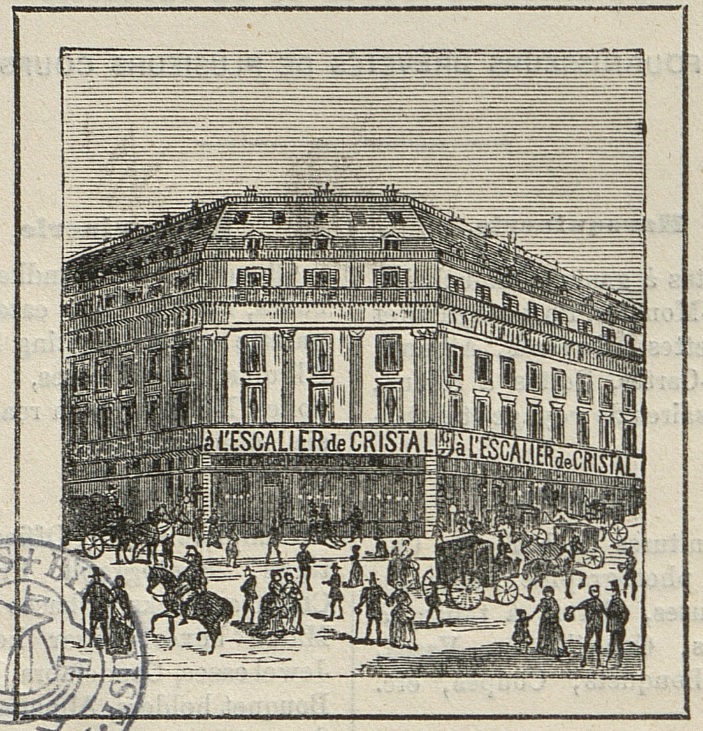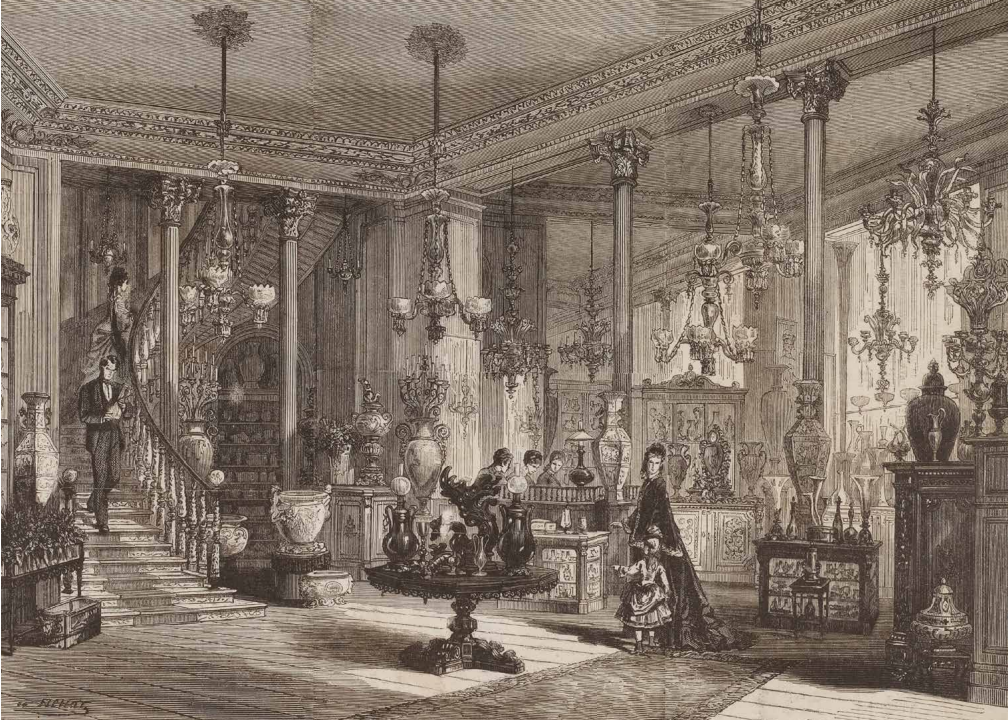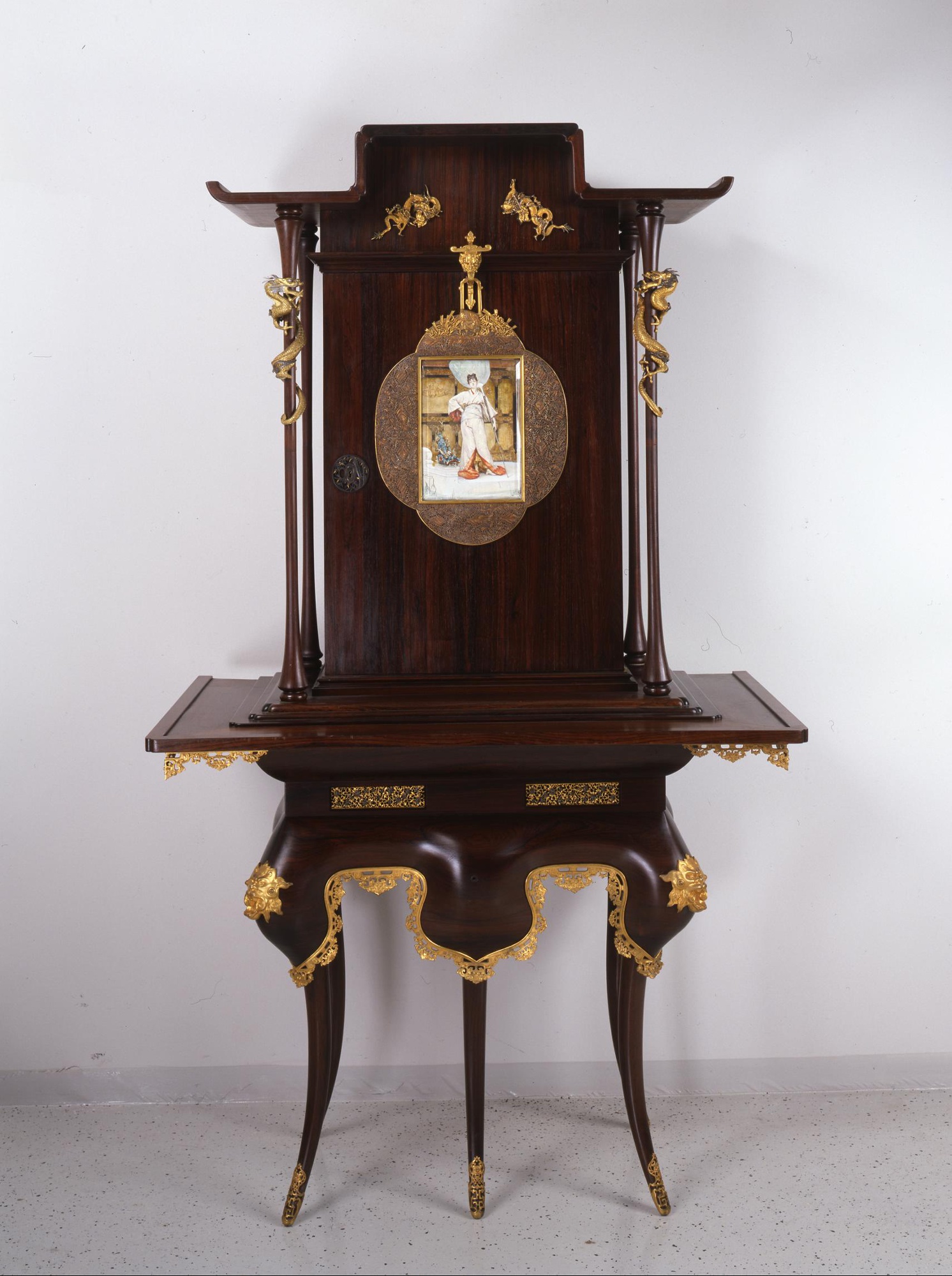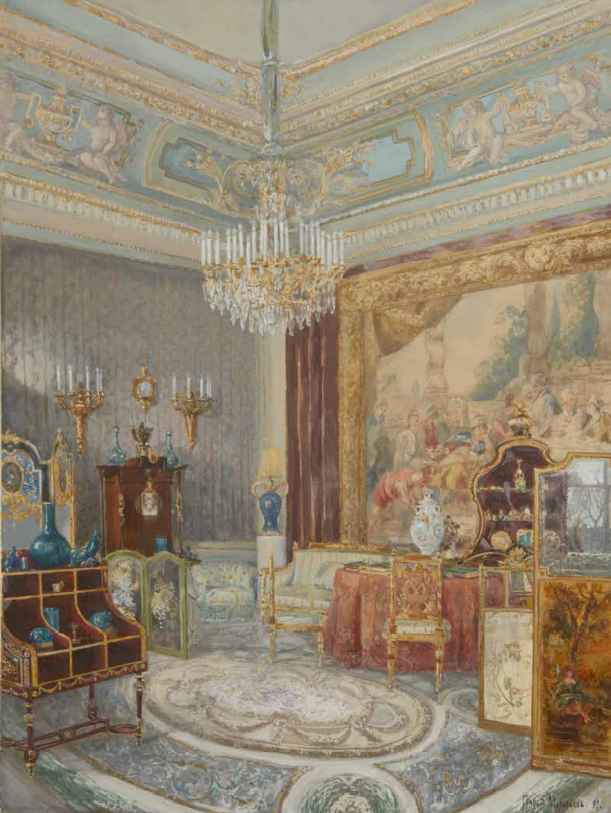The beginning : Gilt bronze and crystal
Marie Jeanne Rosalie Désarnaud (1775 -1842) opens around 1808 her shop in the galleries of the Palais-Royal gardens with her brother Philippe Auguste Charpentier (1781-1815), famous gemstones and crystal engraver.
Quickly the business obtains prestige and reputation. In 1812, they specialize the production by associating the cut crystal with the gilt bronze for the fabrication of decorative arts and furniture like the famous dressing table of the Duchess du Berry (Orsay Museum). The folowing year, they continue to develop the production by adding the selling of cristals, porcelaine and alabaster objects. It’s the same year that a surprising stair with crystal balusters is set in the shop, and becomes its emblem.
Only owner of the store after her brother’s death, in 1815, the Désarnaud widow continues to make her shop thrive. She’s aiming royal customers and obtains the patent of “Cristals supplier of the King”. She participates during the Louvre exhibition in 1819 and is rewarded with a gold medal for the crystals adorned with bronze. It’s during this exhibition that she exhibits the crystal and gilt bronze dressing table with its crystal chair.
As she became a very rich woman, Marie Désarnaud sold her business in 1829 to Jacques Boin, crystal carver and engraver.
The Boin-Lahoche association and the tableware development
In the beginning of the 1830’s, Boin keeps the prestige attached to the Désarnaud widow’s shop as the Royal customers keep coming. Nevertheless, the new name reduced the mention « à l’Escalier de Cristal » to « Boin tailleur et graveur sur cristaux » (Boin carver and engraver on crystals).
Perhaps because of some commercial difficulties, Boin associates in 1840 with another storekeeper, Pierre-Isidore Lahoche, who strongly contributes to the return of the store’s prestige. This new association coincide with the development of the Russian service in France. Needing new pieces for the service, it’s a real chance for the two sellers. Thus, they participate in 1844 in the Exposition des produits de l’industrie, and are noticed by journalists who are giving their approval for the new store production.
The Pannier family
In 1852, Pierre Isidore Lahoche decides to associate with Emile Pannier, son of a ceramicist and married to his daughter, Célina Lahoche.
The 1850’s are also the beginning of the first International Exhibitions to which the store assidiously participates, causing the increase of its reputation in France but also overseas. Wanting to conquer more and more international customers, Lahoche and Pannier do not hesitate to cross the Alantic ocean and show their articles in New York where they were rewarded with a silver medal in 1853. They also are rewarded with another silver medal during the International Exhibition of Paris in 1855 and an order from Napoleon III. He buys them a ruby crystal cut with a gilt bronze cone.
Their success is due to their capacity to follow the trends and the taste of their time. Moreover, caring to touch always more and more customers, Lahoche and Pannier also produce objects more affordable, especially thanks to new proceeds such as the electroplating. Thus, the store allowed more modest customers to buy objects of “good taste” while imagining belonging to a higher social category.
The London International Exhibition of 1862, where their production wins a bronze medal, is the last one to which the partners participate together. In 1863, Lahoche retired from the business. Émile Pannier, thus only manager, keeps the double name a few years to keep the good reputation associated to Lahoche name.
Émile Pannier and the Second Empire changes
The 1867 International Exhibition in Paris is a very important event for Emile Pannier, as it’s his first participation alone. For the occasion, though he still keeps the name of his previous partner, he exhanges the place of the names, his own being read before Lahoche.
L’Escalier de cristal obtains a new bronze medal and many praises. Thus, we can read on the exhibition catalogue « Each exhibition is an occasion to triumph for l’Escalier de cristal ; its reputation seems no to get bigger, and it could take this proud old gentry houses motto : I will maintain. But in the industry, maintaining is progressing. Mr. Pannier-Lahoche, its young and smart director, knows it and prove it. The window displays that were given to him in the palais de l’Industrie are too small to contain all the masterpieces coming out his workshops.
He organizes in his stores in the Palais-Royal a permanent exhibition that allows to judge better the ressources and the importance of his house. It’s there that are set up in all their brigthness, the complete porcelaine tableware and the decorated crystals with gilt bronze mounted and old silver surtouts of which the house has made its speciality[…] ».
The important quality of its production brings to the store a more extended royal clientele. Such as the Tsar, the Austria Emperor, the Spain, Portugal, Prussia, Holland Kings, the Wurtemberg dukes and the Orange and Wales Princes.
The move of the store
After existing almost 70 years and the succession of four different owners, the store l’Escalier de Cristal is moved in the new district of the baron Haussmann, in front of the opera still being built, in the 6 rue Scribe and 1 rue Auber in 1872. Aware of the importance of the famous crystal stairs, true emblem of the store, it is also moved in the new location. Nevertheless, the engravings published in the newspapers show that it now only has one side instead of two. The new store, vaster than the previous one on the Palais-Royal galleries, allows a more extended production and an exhibition more structured looking like a private house, thus, winning the fidelity of the clients.
Engraving of the store facade on the corner of the rue Auber and the rue Scribe in the new opera district.
Paris, Bibliothèque historique de la Ville de Paris
The Pannier brothers, last owners
Émile Pannier gives the store in 1885 to his two sons Georges (1853-1944) and Henry (1855-1935) who he trained. Trends creators, they succeed to maintain, in the decoration field, a high quality tradition, by adapating the production to the taste of the period. Very creative, it’s to Henry that we owe many creation models and a bigger success of the production in the actual market.
Following the store tradition since its beginnings and not possessing real workshops in the company, the Pannier brothers ask the best artists to realize the merchandise. Henry’s notebooks are a true source of informations. We find in it the partners and clients names and very precise draws of the works of art, allowing attributions when the signature is absent. Nevertheless, there are only the objects created for the store and not the ones that have been droped for sell. The only exception is for the ones imagined by Emile Gallé who put his signature next to the store one.
The Japonisme
After the Japan participation to the 1867 International Exhibition and the discovery of its art so different from the traditionnal European criteria, a true enthusiasm appears. The European artistic production follows this trend and many artists and furniture makers specialize themselves in Japan inspired creations, like Lièvre, Viardot or event Rousseau for the glass. The Pannier brothers find in this new trend the occasion to diversify their production. Henry uses especially the Japanese stamps of which he takes the motif to be inspired or to simply use them to serve as decoration on ceramic or glass pieces.
The furniture production
The marriage of Georges with Julie Damon, heir of the famous furniture house Damon-Kriege was advantageous to the idea of the furniture creation.
From 1891, l’Escalier de Cristal appears in the Didot-Bottin for the first time in the “fabrication and selling of furniture” section.
The Henry Pannier’s notebooks permit to have better and almost complete knowledge of the production. We notice that a large part regards the 18th century inspired furniture, still trending in the late 19th century.
Nevertheless, we also see creation furniture inspired by the Japan trend. It seems important to underline the importance of Edouard Lièvre’s influence, of who some draws and models, sold during his after death sell in 1890, were bought by the Pannier brothers. True source of inspiration for some Henry’s creations, it’s a particular model which was the main inspiration for the series of six Japanese cabinets. Four of them have been today found, one in the Hermitage Museum in Saint-Petersburg bought by a Russian client, the grand Duke Wladimir, three others sold recently in auctions.
We also read in the notebooks the participation of important late 19th century furniture making names such as Gabriel Viardot or even Louis Majorelle, other proof of the importance of the store on the artistic scene of this period.
L’Escalier de Cristal, from a model by Edouard Lièvre,
Japanese unit
bought by the Grand Duke Wladimir
kept in the Hermitage Museum in Saint-Petersburg
Closing of the store
L’Escalier de Cristal was closed because of the events that come to disrupt the early 20th century and the sudden death of the main heir.
Indeed, the two brothers have judged that Jean Pannier, Henry’s son was not able to take the direction because of his lack of competences and taste for the arts. On the contrary, Robert, Georges’ son was all destined thanks to the commercial formation he received and his artistic competences. Unfortunatly, he dies in 1907, while he was only 22 years old.
Moreover, even though until now Henry and Georges follow the trends to respond to their clients tastes, we notice that the production lines are not evolving toward the Art Nouveau style and even less the Art Deco style around the 1920’s. Indeed, the decoration which tends to purify is not corresponding to the Pannier brothers spirit.
Finally, the World War I and the Russian revolution of 1917 come to challenge the luxury trade and especially the rich clientele of the store composed in its major part by the Russian gentry.
Discover our other websites
dedicated to houses and artists from the second half of the 19th century
Théodore Deck
Tusey foundries
Fourdinois
Gentil & Bourdet
Victor Geoffroy-Dechaume
Henri Husson
Alfred Janniot
Jules Loebnitz
Paul Sédille
Perret & Vibert
J-Nicolas Rivart
Gabriel Viardot
Find us
120 rue des Rosiers 93400

+33 (0)6 60 62 61 90

contact@marcmaison.com

Copyright © Marc Maison | 2021
Privacy politic







